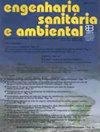Microfauna in the activated sludge treatment of the effluent from a soybean processing industry: a form of evaluation and control of the process
IF 0.5
4区 环境科学与生态学
Q4 WATER RESOURCES
引用次数: 0
Abstract
ABSTRACT Wastewater treatment system by activated sludge, the purification of the organic matter by specific heterogeneous microorganisms, occurs in the presence of oxygen in aeration tanks. The analysis of the microfauna present in the sludge is an important indicator of the performance and efficiency of the activated sludge system. Considering this importance, the objective of this work was to identify the microorganisms which are part of the microfauna present in the aeration tank of the effluent treatment plant of a soybean processing industry in the state of Mato Grosso, evaluating the biological activity of the sludge and the efficiency of the process. Protozoa and bacteria were identified through electronic microscopy and physical-chemical analyses such as pH, dissolved oxygen, nitrogen, phosphorus, BOD, COD, suspended solids, and SVI. During the study, it was possible to identify bacteria related to flake formation, organic matter degradation, nitrification and denitrification, and also microorganisms such as thecamoebas, micrometazoa, fixed ciliates and ciliates free natantes, characterizing the process with good purification and the structure of the sludge flakes between ideal and filamentous bulking with a high sludge age. The identification of the microfauna present was efficient as a bioindicator of the treatment system condition with removal of BOD and COD of 59.75 and 67.09%, respectively.大豆加工业废水活性污泥处理中的微型动物群:过程的一种评价和控制形式
污水处理系统是在曝气池中存在氧气的情况下,通过特定的异质微生物对有机物进行净化的。污泥中存在的微动物群的分析是活性污泥系统性能和效率的重要指标。考虑到这一重要性,本工作的目的是确定马托格罗索州一家大豆加工业污水处理厂曝气池中存在的微型动物群的一部分微生物,评估污泥的生物活性和该过程的效率。通过电子显微镜和理化分析(pH、溶解氧、氮、磷、BOD、COD、悬浮物和SVI)鉴定原生动物和细菌。在研究过程中,可以鉴定出与成片、有机物降解、硝化和反硝化有关的细菌,以及变形虫、微回生动物、固定纤毛虫和游离纤毛虫等微生物,表征了具有良好净化效果的过程,以及污泥年龄较高的污泥片状结构介于理想和丝状膨胀之间。微动物群的鉴定作为处理系统状况的生物指标是有效的,BOD和COD去除率分别为59.75%和67.09%。
本文章由计算机程序翻译,如有差异,请以英文原文为准。
求助全文
约1分钟内获得全文
求助全文
来源期刊

Engenharia Sanitaria E Ambiental
WATER RESOURCES-
CiteScore
0.90
自引率
20.00%
发文量
101
审稿时长
>12 weeks
期刊介绍:
Information not localized
 求助内容:
求助内容: 应助结果提醒方式:
应助结果提醒方式:


